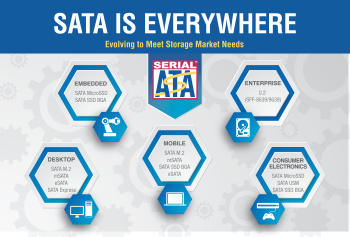
Serial ATA (SATA): Playing an Important Role in the Storage Ecosystem Through Cost, Power and Performance
SATA is truly everywhere today and continues to be a central part in the storage ecosystem: Automotive, Consumer Electronics, Desktop, Embedded, Enterprise and Mobile.
SATA is the evolution of the parallel ATA physical storage interface from a parallel bus to a serial bus architecture. The serial architecture overcomes the electrical constraints that limited continued speed enhancements for the classic parallel ATA bus. SATA provides a well-defined path to progressively higher levels of performance and expanded feature set capabilities available in many technology sectors and form factors. This delivers a competitive storage solution across power, performance and cost.
SATA is the mainstream internal storage interconnect for desktop and mobile PCs, connecting the host system to peripherals such as hard drives, solid state drives, hybrid drives and optical drives. SATA hard drives also have a significant presence in enterprise applications, enabling the integration of higher capacity and cost effective storage solutions.
To learn more about the full extent of the SATA Ecosystem, from integrators to building blocks, power management to port multipliers, select one of the helpful links in the "SATA Ecosystem" sub-menu (above).
Technical Overview
SATA supports 6.0 Gb/s, 3.0 Gb/s and 1.5 Gb/s data transfer speeds and maximizes performance efficiency through features such as Native Command Queuing (NCQ). SATA addresses the ever growing demand for higher capacities and lower costs by supporting the latest storage innovations, including Shingled Magnetic Recording (SMR). Additionally, DEVSLP and other advanced power management capabilities make the SATA interface a competitive technology for low-power storage solutions. SATA-IO has recently added new compliance standards to improve host-to-data reliability, device compatibility and low power exit robustness.
The SATA-IO is committed to supporting new technologies and techniques in performance, power management, physical configuration, and connection options. This gives SATA a long and promising future across all storage vertical integration sectors including Automotive, Consumer Electronics, Desktop, Mobile, Embedded and Enterprise applications.